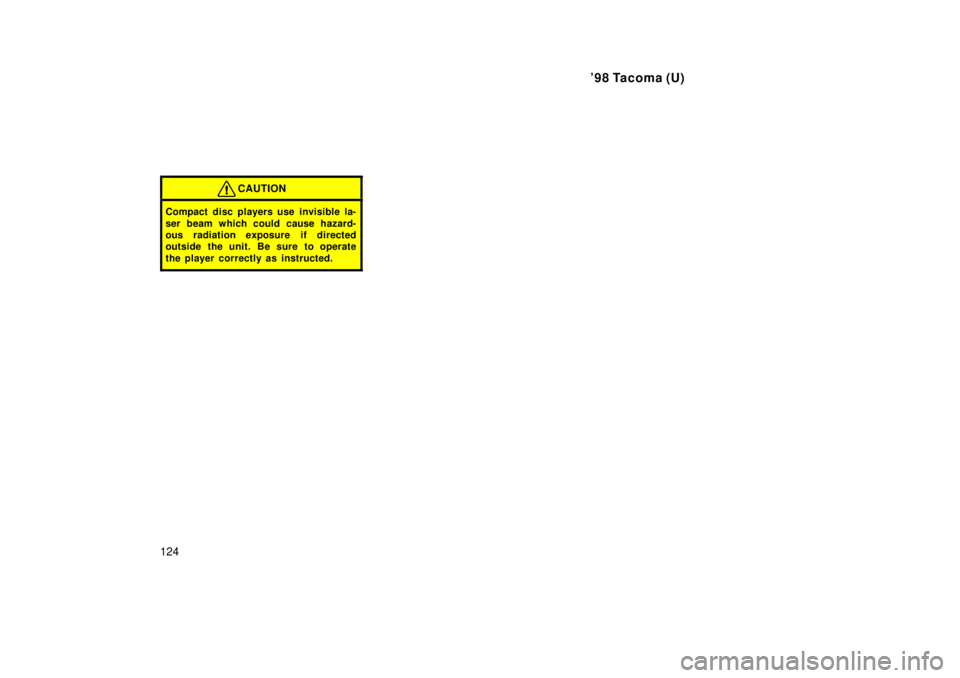TOYOTA TACOMA 1998 Owners Manual
Manufacturer: TOYOTA, Model Year: 1998, Model line: TACOMA, Model: TOYOTA TACOMA 1998Pages: 246, PDF Size: 4.33 MB
Page 121 of 246

'98 Tacoma (U)121
ST (Stereo reception) display
Your radio automatically changes to stereo
reception when a stereo broadcast is re-
ceived. ºSTº appears on the display. If the
signal becomes weak, the radio reduces
the amount of channel separation to prev-
ent the weak signal from creating noise.
If the signal becomes extremely weak, the
radio switches from stereo to mono recep-
tion.
TRACK (Track up/down button):
Compact disc player
By using this button, you can skip up or
down to a different track.
Push either side of the track button until
the number of the track you want to listen
to appears on the display. If you want to
return the beginning of the current track,
push the down side of the button one
time, quickly.
TUNE (Tuning)
Tuning
Your Toyota has an electronic tuning radio
(ETR). Push and release the º
~º (up) or
º ! º (down) side of ºTUNEº to step up or
down the station band. (If you hear a
beep, you held the button too long and
the radio will go into the seek mode.) Seeking
In the seek mode, the radio finds and
plays the next station up or down the
station band.
To seek a station, push and hold the º
~º
or º !º side of ºTUNEº until you hear a
beep. Do this again to find another sta-
tion.
NOTICE
To ensure the correct audio system
operation:
�Be careful not to spill beveragesover the audio system.
�Do not put anything other than acassette tape or Compact Disc into
the slot.
RADIO RECEPTION
Usually, a problem with radio reception
does not mean there is a problem with
your radio Ðit is just the normal result of
conditions outside the vehicle.
For example, nearby buildings and terrain
can interfere with FM reception. Power
lines or telephone wires can interfere with
AM signals. And of course, radio signals
have a limited range, and the farther you
are from a station, the weaker its signal
will be. In addition, reception conditions
change constantly as your vehicle moves.
Here are some common reception prob-
lems that probably do not indicate a prob-
lem with your radio:
ÐCar audio system operating
hints
Page 122 of 246

'98 Tacoma (U)
122
FM
Fading and drifting stationsÐGenerally, the
effective range of FM is about 40 km (25
miles). Once outside this range, you may
notice fading and drifting, which increase
with the distance from the radio transmit-
ter. They are often accompanied by distor-
tion.
Multi-pathÐFM signals are reflective, mak-
ing it possible for two signals to reach
your antenna at the same time. If this
happens, the signals will cancel each oth-
er out, causing a momentary flutter or
loss of reception.
Static and flutteringÐThese occur when
signals are blocked by buildings, trees, or
other large objects. Increasing the bass
level may reduce static and fluttering.
Station swappingÐIf the FM signal you
are listening to is interrupted or weak-
ened, and there is another strong station
nearby on the FM band, your radio may
tune in the second station until the origi-
nal signal can be picked up again.
AM
FadingÐAM broadcasts are reflected by
the upper atmosphere±especially at night.
These reflected signals can interfere with
those received directly from the radio sta-
tion, causing the radio station to sound
alternately strong and weak.
Station interferenceÐWhen a reflected sig-
nal and a signal received directly from a
radio station are very nearly the same
frequency, they can interfere with each
other, making it difficult to hear the broad-
cast.
StaticÐAM is easily affected by external
sources of electrical noise, such as high
tension power lines, lightening, or electri-
cal motors. This results in static.
CARING FOR YOUR CASSETTE PLAYER
AND TAPES
For high performance from your cassette
player and tapes:
Clean the tape head and other parts regu-
larly.
� A dirty tape head or tape path can
decrease sound quality and tangle your
cassette tapes. The easiest way to
clean them is by using a cleaning tape.
(A wet type is recommended.) Use high-quality cassettes.
� Low-quality cassette tapes can cause
many problems, including poor sound,
inconsistent playing speed, and
constant auto-reversing. They can also
get stuck or tangled in the cassette
player.
� Do not use a cassette if it has been
damaged or tangled or if its label is
peeling off.
� Do not leave a cassette in the player
if you are not listening to it, especially
if it is hot outside.
� Store cassettes in their cases and out
of direct sunlight.
� Avoid using cassettes with a total play-
ing time longer than 100 minutes (50
minutes per side). The tape used in
these cassettes is thin and could get
stuck or tangled in the cassette player.
Page 123 of 246

'98 Tacoma (U)123
CARING FOR YOUR COMPACT DISC
PLAYER AND DISCS� Use only compact discs labeled as
shown.
� Extremely high temperatures can keep
your compact disc player from working.
On hot days, use the air conditioning
to cool the vehicle interior before you
listen to a disc.
� Bumpy roads or other vibrations may
make your compact disc player skip. �
If moisture gets into your compact disc
player, you may not hear any sound
even though your compact disc player
appears to be working. Remove the
disc from the player and wait until it
dries.
� Handle compact discs carefully, espe-
cially when you are inserting them.
Hold them on the edge and do not
bend them. Avoid getting fingerprints
on them, particularly on the shiny side.
� Dirt, scrapes, warping, pin holes, or
other disc damage could cause the
player to skip or to repeat a section of
a track. (To see a pin hole, hold the
disc up to the light.)
� Remove discs from the compact disc
player when you are not listening
to them. Store them in their plastic
cases away from moisture, heat, and
direct sunlight.
To clean a compact disc: Wipe it with a
soft, lint- free cloth that has been damp-
ened with water. Wipe in a straight line
from the center to the edge of the disc
(not in circles). Dry it with another soft,
lint- free cloth. Do not use a conventional
record cleaner or anti- static device.A new disc may have rough edges on
its inner and outer perimeter. Remove
the rough edges by pressing the side
of a ball- point pen or pencil against
the inner and outer perimeter of the
disc as shown.
If you continue to play a disc with rough
edges, flakes will fall on to the signal side
of the disc and cause sound skipping or
other problems.
Page 124 of 246

'98 Tacoma (U)
124
CAUTION
Compact disc players use invisible la-
ser beam which could cause hazard-
ous radiation exposure if directed
outside the unit. Be sure to operate
the player correctly as instructed.
Page 125 of 246

'98 Tacoma (U)125
1. Air Intake Selector
2. Temperature Selector
3. Air Flow Selector
4. Fan Speed Selector
5. ºA/Cº Button (on some models)
Air conditioning systemÐ
ÐControls
Page 126 of 246

'98 Tacoma (U)
126
Fan speed selector
Move the lever to adjust the fan speedÐ
to the right to increase, to the left to
decrease.
Temperature selector
Turn the knob to adjust the temperatureÐ
to the right to warm, to the left to cool.
Air flow selector
Turn the knob to select the vents used for
air flow.
1. Panel ÐAir flows mainly from the
instrument panel vents.
2. Bi-level ÐAir flows from both the floor
vents and the instrument panel vents.
3. Floor ÐAir flows mainly from the floor
vents.
4. Floor/Windshield ÐAir flows mainly
from the floor vents and windshield
vents.
5. Windshield ÐAir flows mainly from the
windshield vents. For details about air flow selector settings,
see the illustration after ºA/Cº button.
Vehicles with ºA/Cº buttonÐ
Turning the air flow control knob to wind-
shield position turns on the defroster-
linked air conditioning. This is to clear up
the front view more quickly.
When the ºA/Cº button is not pressed in,
turning the air flow control knob to anoth-
er position turns off the air conditioning.
Page 127 of 246

'98 Tacoma (U)127
Air intake selector
Move the lever to select the air source.1. Recirculate ÐRecirculates the air inside
the vehicle.
2. Fresh ÐDraws outside air into the sys-
tem. ºA/Cº button
To turn on the air conditioning, press the
ºA/Cº button. The ºA/Cº button indicator
will come on. To turn the air conditioning
off, press the button again.
If the ºA/Cº button indicator flashes, there
is a problem in the air conditioning system
and the air conditioning automatically
shuts off. If this happens, take your ve-
hicle to a Toyota dealer for service.
Page 128 of 246

'98 Tacoma (U)
128
ÐAir flow selector settings
ÐOperating tips
� To cool off your Toyota after it has
been parked in the hot sun, drive with
the windows open for a few minutes.
This vents the hot air, allowing the air
conditioning to cool the interior more
quickly.
� Make sure the air intake grilles in front
of the windshield are not blocked (by
leaves or snow, for example).
� On humid days, do not blow cold air
on the windshield. The windshield could
fog up because of the difference in air
temperature on the inside and outside
of the windshield.
� Keep the area under the front seats
clear to allow air to circulate through-
out the vehicle.
� On cold days, move the fan speed to
ºHIº for a minute to help clear the in-
take ducts of snow or moisture. This
can reduce the amount of fogging on
the windows.
Page 129 of 246

'98 Tacoma (U)129
Heating
For best results, set controls to:
Fan speed ÐAny setting except ºOFFº
Temperature ÐTowards WARM
(red zone)
Air intake ÐFRESH (outside air)
Air flow ÐFLOOR
Air conditioning ÐOFF
� For quick heating, select recirculated
air for a few minutes. To keep the
windows from fogging, select fresh af-
ter the vehicle interior has been
warmed.
� Press the ºA/Cº button on for dehumidi-
fied heating.
� Choose floor/windshield air flow to heat
the vehicle interior while defrosting or
defogging the windshield. Air conditioning
For best results, set controls to:
Fan speed ÐAny setting except ºOFFº
Temperature ÐTowards COLD
(blue zone)
Air intake ÐFRESH (outside air)
Air flow ÐPANEL
Air conditioning ÐON� For quick cooling, move the air intake
selector to recirculate for a few min-
utes.
Ventilation
For best results, set controls to:
Fan speed ÐAny setting except ºOFFº
Temperature ÐTowards COLD
(blue zone)
Air intake ÐFRESH (outside air)
Air flow ÐPANEL
Air conditioning ÐOFF
Defogging
The inside of the windshield
For best results, set controls to:
Fan speed ÐAny setting except ºOFFº
Temperature ÐTowards WARM
(red zone) to heat;
COLD (blue zone) to cool
Air intake ÐFRESH (outside air)
Air flow ÐWINDSHIELD
Vehicles with ºA/Cº buttonÐ
Turning the air flow control knob to wind-
shield position turns on the defroster-
linked air conditioning. This is to clear up
the front view more quickly.
When the ºA/Cº button is not pressed in,
turning the air flow control knob to anoth-
er position turns off the air conditioning.
� On humid days, do not blow cold air
on the windshieldÐthe difference be-
tween the outside and inside tempera-
tures could make the fogging worse.
Page 130 of 246

'98 Tacoma (U)
130
Defrosting
The outside of the windshield
For best results, set controls to:
Fan speed ÐAny setting except ºOFFº
Temperature ÐTowards WARM
(red zone)
Air intake ÐFRESH (outside air)
Air flow ÐWINDSHIELD
Vehicles with ºA/Cº buttonÐ
Turning the air flow control knob to wind-
shield position turns on the defroster-
linked air conditioning. This is to clear up
the front view more quickly.
When the ºA/Cº button is not pressed in,
turning the air flow control knob to anoth-
er position turns off the air conditioning.
� To heat the vehicle interior while de-
frosting the windshield, choose floor/
windshield air flow. ÐSide vents
If air flow control is not satisfactory, check
the side vents. The side vents may be
opened or closed as shown.